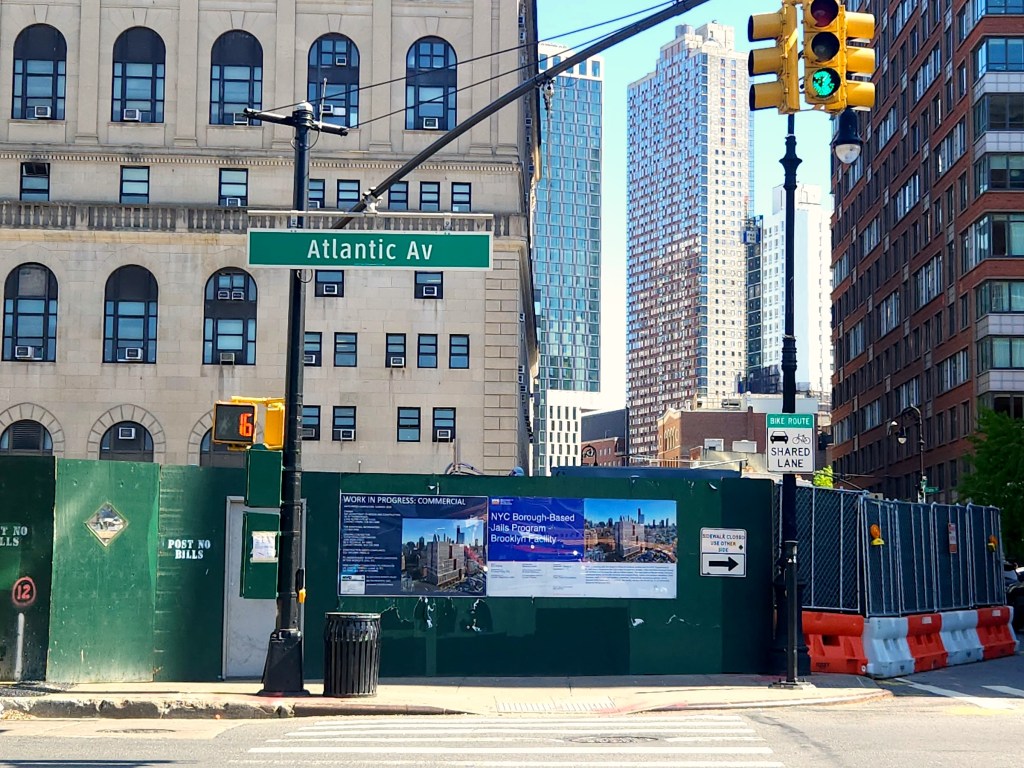Why Is For Freedoms Designing Art for a New Brooklyn Jail?


As artists and activists continue to organize against the building of new jails in New York City as part of a project to close the notorious and deadly Rikers Island facility, public records reviewed by Hyperallergic show that the art collective For Freedoms received first-phase approval for a series of artworks intended for the forthcoming detention center in Downtown Brooklyn.
The controversial Borough-Based Jails (BBJ) project, established in 2018, involves the construction of four new, smaller jails in Manhattan, Brooklyn, Queens, and the Bronx. The Department of Cultural Affairs (DCLA) approached For Freedoms for a project proposal through the Percent for the Art program, which facilitates art commissions and acquisitions in accordance with the 1982 law requiring that one percent of city-funded construction budgets is allocated for public art. DCLA’s call for artworks for the new jail sites has generated pushback from artists and organizers who are critical of the BBJ project.
Titled “Stories Shape Reality,” For Freedoms’s proposed commission for the Brooklyn jail is led by the collective’s co-founder Eric Gottesman and its Executive Director Claudia Peña in collaboration with artists Bryonn Bain, Jared Owens, and Jamel Shabazz. Founded in 2016 by Gottesman, Hank Willis Thomas, Michelle Woo, and Wyatt Gallery, For Freedoms presents collaborative art interventions to probe national and international structures of power. Initially kicking off with political billboard campaigns leading up to the 2016 presidential election, For Freedoms has since evolved to include interactive activations, artist-led town halls, and gallery and museum exhibitions.

According to a proposal deck reviewed by Hyperallergic, “Stories Shape Reality” will incorporate 50 personal accounts from people “impacted by the Borough Based Jail facility in Brooklyn” — including 25 people in custody, 10 facility staffers, 10 family members of people in custody, and five neighbors of the facility — in an “oral histories archive” that will be both physically available for those incarcerated and publicly available online. Various artworks interpreting stories from the archive will be installed inside and outside the jail, including the staff entrance, the contact visiting room and programs space, the outdoor public plaza, and the lobby.
“This has been a very complex project,” For Freedoms shared in a statement responding to Hyperallergic’s inquiries. “From the outset, Percent for Art has prioritized ensuring that this work serves people in custody, and our negotiations continue to be guided by this shared commitment.”
Hyperallergic also asked For Freedoms for its insights regarding local artists’ and prison abolitionists’ criticisms of the BBJ program and calls for art in the new detention centers.
“At every stage, we have been and will be, navigating with different city agencies to see how and if we can continue with this project,” For Freedoms’s statement continued. “Our process has been informed by our deep relationships with directly system- impacted people and artists to reflect their experiences.”
Marcus Manganni, a Brooklyn-based artist and an initial collaborator on the For Freedoms proposal, confirmed with Hyperallergic that he withdrew from the project ahead of its conceptual approval, but underscored that he “proudly stand[s] with For Freedoms as they have centered the voices of directly system-impacted people from the inception of the idea for the project and throughout this entire process.”
“It’s unfortunate but ultimately, I decided to cancel my project with full support from For Freedoms,” he clarified.
Manganni initially participated as an artist whose sculptural installation practice directly addresses his own time in the system. Recalling the limited means of art making while held in solitary confinement, Manganni uses light reflection and refraction, solar mapping, and architectural forms as mediums to probe state-sanctioned violence and isolation deployed against people in custody.
“Eric [Gottesman] and Claudia [Peña] have fiercely supported my artistic practice, my spirit, and my vision more than anyone could possibly imagine,” Manganni continued.

Peña teaches law and restorative justice courses at the University of California, Los Angeles (UCLA) as well as the Prison Education Program through which UCLA students take courses along with people who are incarcerated. She serves as the founding co-director of the UCLA’s Center for Justice alongside Bain, who also teaches college courses in the carceral system and uses his spoken word practice to expand on his wrongful arrest in New York City. Famed street and documentary photographer Jamel Shabazz worked as a corrections officer from 1983 to 2003 on Rikers Island, and Owens uses his art to advocate for prison reform, reflecting on his personal experience in custody to target the national crisis of mass incarceration.
Having been selected out of three finalist submissions in December 2023, For Freedoms’s proposal received unanimous conceptual approval from the NYC Public Design Commission as of July 15, 2024 with a listed budget of $900,000. The next step is returning to the local community board and the Public Design Commission this year for preliminary (second phase) approval.
For Freedoms’s jail art proposal comes against the backdrop of anger from local artists over DCLA’s call for art in the new detention centers coupled with criticism of the funds allocated to the BBJ plan in lieu of crime prevention resources across the city. In an opinion for Hyperallergic last December, artist and educator Chloë Bass said she was also approached to submit a proposal for the new jails, which she turned down, arguing that “the only ethical use of a several hundred thousand dollar budget under these conditions is to use every cent of it to support organizations working to dismantle the carceral system.”
“An invitation to create a permanent public commission in a jail, prison, or detention center indicates a belief that these buildings, and the systems they represent, are also permanent,” Bass wrote.
Though activists and artists alike have long advocated for the closure of Rikers Island due to hard-to-access location, abusive conditions, unjust detention, documented human rights violations, and continuously updated track record of deaths in custody, they’ve also fought against the BBJ plan when it was introduced in 2018.
Like Bass, other prison abolitionist activists and organizations have criticized the billions of dollars the city has allocated to building new, ostensibly “humane” detention facilities of skyscraper dimensions rather than investing in proven crime- and harm-reduction measures in disadvantaged communities. Both residents and organizers fighting against gentrification and displacement in Chinatown have lambasted the demolition and reconstruction of the Manhattan Detention Center on White Street in accordance with the BBJ project, saying that the city never considered the local impact of the new facility.


The Chinatown Art Brigade and the WOW Project published an open letter calling on DCLA as well as the NYC Department of Design and Construction to stop commissioning artworks for the four new detention facilities. The letter garnered 32 signatures from local cultural and community organizations including the Abron Arts Center, ABC No Rio, Storefront for Art and Architecture, and Think!Chinatown.
In an interview with Hyperallergic, Brooklyn artist Cindy Hwang, who organizes with the Lower Manhattan activist coalition Art Against Displacement, said that while there should be more opportunities for formerly incarcerated artists, “ they don’t have to take the form of decorating a jail.”
“At the end of the day, that’s just making the jail seem like a permanent part of the fabric of society — especially if impacted artists are participating in it,” Hwang continued. “ I think For Freedoms still has the opportunity to pull out and make a statement that we should not be cooperating with any kind of carceral architecture.”
Hyperallergic connected with Jared Owens, a city-based and formerly incarcerated artist collaborating with For Freedoms on the proposal, regarding criticisms of the BBJ plan and the call for art in the new detention centers.

“If [critics] don’t even know what it means to be inside a prison, then there’s no conversation for us to even have,” Owens said plainly. He suggested that they should focus their attention on ensuring that the state turns Rikers Island into an education center after depopulating it.
“[Critics] don’t understand what it’s like to be brutalized by your surroundings and by the architecture 24/7, and then have one place inside the jail where there’s a mural or another place to refuge that people actually want to go and see,” Owens continued. “ My experience was to walk into a room and see art — to see paintings — and recall how therapeutic it is.”
While serving his sentence in federal custody, Owens rediscovered his love of creating through an onsite ceramics program. His self-taught practice soon expanded to incorporate portraiture, drawing, and other avenues of expression derived from limited materials, oftentimes sourced from debris, natural resources like soil, and repurposed daily objects including plastic spoons, hair gel, and bed sheets.
Owens noted to Hyperallergic that original plans to facilitate regular art education programming for people in custody were shut down by the state due to the inability to secure continuous staffing for them, so For Freedoms and its collaborators centered the proposal on making the jail “less visibly Brutalist.”
Neither Shabazz nor Bain responded to Hyperallergic’s inquiries.
The Brooklyn Jail is slated to be completed in 2029 with the artwork commission, should For Freedom’s proposal move forward as planned.



